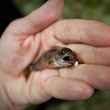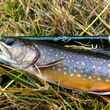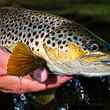It has been said that anglers go through several stages during their angling lives. Recently, I’ve entered the stage where I am focused on simplifying the gear and patterns I use. I’ve also transitioned to fishing more warm water species within the last 6 years, including my current favorite—smallmouth bass. As a recreational smallmouth angler, I find it easy to decrease my selection. I’m not guiding for bass or entering bass tournaments where carrying a greater range of patterns might prove useful during the rare times when my staple patterns fail to produce a strike. This is why, from late spring to early fall, I only carry two streamer patterns with me—Game Changers and Murdich Minnows.
Game Changers
The Game Changer is one of the hottest patterns in the fly fishing world and for good reason—it has lifelike movement and catches fish. But even a superpattern has its kryptonite, and for the Changer it's the cost and time required to tie the pattern. I’m a slow tier and it usually takes me a minimum of 25-30 minutes to tie even the smaller Game Changers. I still tie and buy Game Changer patterns, but I only use them during the most challenging conditions, when wary fish demand the best fly presentation. Most often, this is when fishing highly pressured water or low flows.
Otherwise, I find the Game Changer to be overkill for many of the bass water I fish. Yes, they receive pressure, but nowhere near the pressure other popular bass fisheries receive. Plus, younger small to medium size bass make up the bulk of fish I present my patterns to and are often not too picky when eating.
Murdich Minnows
Although originally designed for striped bass, the Murdich minnow continues to connect anglers with countless freshwater and saltwater fish across the globe. The Murdich has some of the best action of any single-shank streamer pattern on the market today. It’s easy and less expensive to tie than many popular streamer patterns today. Even as someone who’s a bit slow at the vise, I can crank a Murdich out within three minutes.
One thing I like about the Murdich is that its single shank design means I can pitch it under tight brush without fear of it fouling. A short, erratic casting stroke is often all we have when trying to present a fly in tight cover and articulated patterns easily foul (turning into bait balls) when using a short, overpowered casting stroke. This is why I’ll usually switch to a single shank streamer when approaching stream sections with little casting room.
Nothing is more frustrating than when you perfectly present your streamer under tight brush only to find out that your multiple shank pattern fouled itself and turned into a bait ball. Bass are ambush predators and the tighter you can present your streamer to wood, the better your results are likely to be. In addition to being single-shanked, the Murdich Minnow is light and can easily be skipped on the surface to shoot a presentation deep under the brush. Even in the larger sizes I use for musky fishing, the lightweight Murdich is a pleasure to cast.
I’ll happily fish Murdich minnows aggressively in tight cover while with expensive Game Changers, I’ll find myself being cautious due to the cost and time involved in tying these lifelike streamers. If I lose a Murdich, I only lose three minutes of my life and a dollar of materials. If I lose a Game Changer, I’m out 20-40 minutes of my life and six times the materials cost.
Fly Construction
I use a Tiemco 8089 streamer hook in sizes 6-10, but any streamer hook will work. Before attaching thread, I’ll add 8-12 wraps of .015-.025 lead wire around the lower third of the bend to act as a keel. The keel keeps the hook riding hook point down and provides more momentum for the pattern to glide during the pause between strips. A few drops of superglue are applied to lock in the lead wire.
The diameter of lead wire depends on how deep you want to fish the pattern. My preference is for .015 to keep the pattern light and neutrally buoyant. The one thing I’m finding out about smallmouth is many of the strikes occur during the pause as the fly hangs in the water column. A heavy fly that quickly drops in front of an interested bass often seems to be a turnoff more than an attraction. I also like long pauses between strips and a heavy fly tends to snag bottom during such long-pause retrieves.

Bucktail forms the foundation for the flashy tail and a liberal amount of pearl flashabou strands are laid on top of the deer hair. The stiff tail acts as a rudder, creates buoyancy, and prevents the flashabou tail from fouling around the hook shank. The amount of flash used depends on how much bling you want in the presentation. I’ll add a liberal amount of flash at the tying table but can easily thin out with scissors on the stream. It’s easier to trim flash than to add it streamside. Make sure to tie in the bucktail so the hair doesn’t flash off the sides when applying thread. What you’re looking for is a tight bunch of bucktail tip fibers clumped together. Use light thread wraps at first to keep the hair from flaring and then add additional pressure to lock in the bucktail fibers.
Some fly tiers add a small rattle on the rear hook shank. I may use rattles early in the season when dealing with higher and off-color water, but I rarely use them from late spring to summer. The rattle does add bulk to the rear shank, which is part of the design, where there’s a bulge near center-between the tail and head. This bulge can be constructed of any number of materials, but a pinch of synthetic fiber doubled over and tied back on both sides is a popular choice, which aids in causing the fly to kick sideways during the presentation. The rest of the body is usually an Estaz chenille in size Grande. If desired, stick-on eyes can be applied.
White is my most productive color but sharpie markers can be used to color the pattern. I like the visibility of white in the water and will set the hook when I see the white disappear. Smallmouth tend to inhale (not grab) the fly while swimming towards you. Watching the fly disappear is often a quicker indicator to set the hook than waiting to feel the tug. Always make sure to debarb your hook as bass tend to take the fly deep.
Presentation
A floating or slow intermediate line are my two favorite lines for presenting this neutrally buoyant streamer. Leader formula is a simple two-part system: Half 20-25 lb and half 12-15 lb. I’ll use an 8-9’ leader with my floating line during extreme low flows and a 6-8’ leader when using an intermediate line. Because I employ long pauses, a loop knot provides more movement between strips. For bass, I most often use a short powerful strip (approximately 1-3”), followed by a long pause (3-10 seconds) between strips. The pause allows the Murdich to glide off to the side and then course correct itself. This isn’t usually a 90-degree kick but more like a 45 — just enough to provide any following predator a side view, hopefully enticing a T-bone strike.
The biggest challenge for a trout angler learning to fish for smallmouth is the long pause between strips. Be patient. Watch a three to four foot area around the streamer during the retrieve and pay attention to the fish’s body language. Often, you’ll see bass starting to follow the streamer from a distance only to turn away when the pattern is retrieved too fast or erratically. Think of fishing the Murdich the same way you’d fish a hopper pattern—a long drift with a few twitches. This approach best imitates a wounded or dying baitfish—an easy meal for any predator.

If bass approaches—just drift the pattern. If you see the fish lose interest, send a few short pulses into the pattern. I don’t think most trout anglers realize how much finesse and excitement there is in fishing for smallmouth bass, especially with streamers. What I enjoy most is the visual eats—seeing a large shadow approach the streamer or watching the large white pattern disappear during the presentation. There are many good reasons I've been spending more time chasing smallmouth bass during these last 6 years and the Murdich minnow has been one of my top producing streamers.





























Comments
Charles P. replied on Permalink
Do you add any tippet to the end if your leader formula? Thank you!
Pages